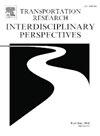Tracking wildfire risk to California railroads: integrating environmental data and railway operations
IF 3.8
Q2 TRANSPORTATION
Transportation Research Interdisciplinary Perspectives
Pub Date : 2025-07-01
DOI:10.1016/j.trip.2025.101526
引用次数: 0
Abstract
Climatic change and wildfire risk have direct implications for the railway industry. Wildfires pose risks to railways in areas with steep topography, sufficient fuels to sustain fire, and meteorological conditions that can ignite large fires. Railway infrastructure and operations also increase the risks of ignition from flammable materials used in track or bridge construction, engine and braking, which can generate sparks, and vegetation management, which can increase fuel for fires. A methodology was developed to identify California railway segments exposed to wildfire risk. Five potential railway segments were identified based on the proximity of the track to areas of burn probability and the relative area for different classes of burn probability. Two segments were selected based on the total area classified as high and very high burn probability and the length of track exposed to very high burn probability. These segments were evaluated regarding land cover, slope, meteorological conditions, and adaptive capacity. Heightened wildfire risk was found in these two segment areas due to complex terrain, meteorological conditions conducive to fire, and large extents of flammable vegetation. The data and methods tested in this study are replicable and scalable and represent initial work in developing a broader vulnerability assessment framework on the exposure, sensitivity, and adaptative capacities of railways exposed to wildfire and other climate hazards at the state or regional level.
追踪加州铁路的野火风险:整合环境数据和铁路运营
气候变化和野火风险对铁路行业有直接影响。在地形陡峭、燃料充足、气象条件可能引发大火的地区,野火对铁路构成威胁。铁路基础设施和运营也增加了轨道或桥梁建设、发动机和制动中使用的易燃材料引发火灾的风险,这些材料会产生火花,植被管理也会增加火灾的燃料。开发了一种方法来确定加州面临野火风险的铁路路段。根据轨道与燃烧概率区域的接近程度和不同类型燃烧概率的相对面积,确定了5个潜在的铁路段。根据被划分为高和非常高燃烧概率的总面积以及暴露在非常高燃烧概率下的轨道长度选择了两个部分。根据土地覆盖、坡度、气象条件和适应能力对这些区段进行了评估。由于地形复杂,气象条件利于火灾,以及大面积的易燃植被,这两段地区的野火风险较高。本研究中测试的数据和方法具有可复制性和可扩展性,代表了在国家或地区层面制定更广泛的脆弱性评估框架、敏感性和铁路面临野火和其他气候灾害的适应能力方面的初步工作。
本文章由计算机程序翻译,如有差异,请以英文原文为准。
求助全文
约1分钟内获得全文
求助全文
来源期刊

Transportation Research Interdisciplinary Perspectives
Engineering-Automotive Engineering
CiteScore
12.90
自引率
0.00%
发文量
185
审稿时长
22 weeks
 求助内容:
求助内容: 应助结果提醒方式:
应助结果提醒方式:


